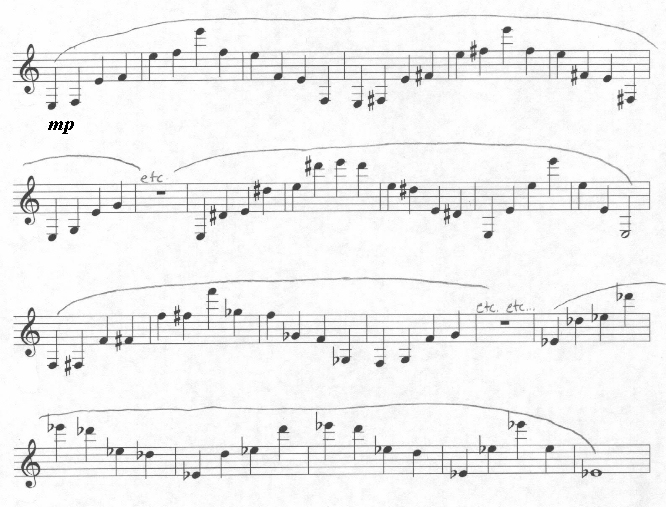Advanced Daily Warm-Up for the Clarinet
A warm-up is one of the most important things a clarinettist can do. It is especially important to students who wish to become professionals, because the daily warm-up will enable them to isolate and concentrate on the fundamentals so important to professional clarinet playing. This is the warm-up I used during my study, portions of which I still do today on a daily basis. The whole warm-up takes 20-30 minutes, depending on how much of it you do. I have listed the five components in order of importance.
Long Tones
Long tones are the most important fundamental exercise to any wind instrument. My long tones are executed thusly:

Breathe through your nose in the 1/4 bars, maintaining your embochure.
What to concentrate on: good embochure, good air stream (i.e. support, tongue position, relaxed body, chest, and neck), and consistent, unwavering, beautiful tone. This exercise is also to warm up your embochure muscles, and increase their endurance. Stop the long tones either when you get to tired to maintain proper embochure (i.e. leaking air, chin collapsing, etc.), or when you reach the throat B-flat.
Scales
Scales are important to maintaining facile fingers, and because all tonal western music is based on them. You should know your Chromatic scale from Low E to Double-high C. My favorite diatonic scales are from Rudolf Jettel's Klarinettenschule, Book 2.
Execution: Play Chromatic every day, and alternate major and minor every other day. Start at a comfortable fast tempo (for me, 138) and work them up in five steps to a very fast tempo (for me, 200). If you do not know your scales this fast, work them up to these tempos and keep them in your daily warm-up as you work up the others in your normal practice sessions.
What to concentrate on: Maintaining good embochure, airstream, tone, and dynamics in all ranges; and fluid, even motion of fingers.
Tonguing
If you have slow, inconsistent, heavy, or unsatisfying articulation, this exercise is guaranteed to help.

Execution for speed: Find a tempo where you just barely get to the last note of the exercise on time, and repeat it until it feels like your tongue is going to fall off from fatigue. This may take up to five minutes of playing. Concentrate on consistent, crisp articulation, using the syllable "ta" in your thoughts. Do not try to play the 16ths staccato. The quarters are to be long, except when you breathe after the first quarter note when necessary. After you have rested your tongue for 20-30 seconds, play the exercise again until it feels like your tongue is going to fall off, then you are through with it. If you are willing to work harder, do it once in the morning and once at night. In several days or weeks, when you consistently get to the last note of the exercise on time, move your metronome up one click (standard Metronome marking) - but not before this time. Continue this pattern until you reach your limit of speed, and maintain the exercise daily to keep your tongue fast and crisp. Professionals should be able to tongue sixteenth notes at a minimum of mm. 144.
Execution for consistency: Mostly for younger players or anyone trying to get their tongue in the proper place. Choose a comfortable tempo, moderate length of notes, and practice for approx 5 minutes, concentrating on consistency. As you approach your goals, vary the articulation for each session, but not within one session, between legato, staccato, and in-between.
Intonation and dynamic long tones
These are similar to the first long tones, but this time with dynamics:

Play with a metronome and tuner, shading the notes to keep consistent pitch. Try to shade with fingers/keys first, and then with embochure to maintain consistent tone.
What to concentrate on: Maintaining good tone, intonation, air stream, and embochure at all dynamics.
Variations after mastery of the original: Four counts up - four counts down, Two and two (full dynamic range with control, intonation, tone, etc.); Reverse-Dynamic Long Tones: Start FFF, go to N and back (vary with number of clicks); 8 up - 8 down but dynamic from niente to pp and back (great for control, esp. in Altissimo).
Abato studies
These studies, invented by Vincent "Jimmy" Abato - Bass Clarinetist of the Metropolitan Opera may be broken up and spread over several daily warm ups. The exercise, played Andante, is:

To paraphrase Stanley Hasty: "Anyone can play a beautiful note, but very few people can play a beautiful interval."
What to concentrate on: Legato. Consistent tone and intonation. These are excellent advanced exercises for Legato Fingers, and keep that technique in fine condition when executed daily, even in part.
Any serious daily warm-up encompasses the Long-Tones and Scales, and to this day I still do them. The other three parts are for focusing on specific problems, or for the truly dedicated, but they can be of service to all.



